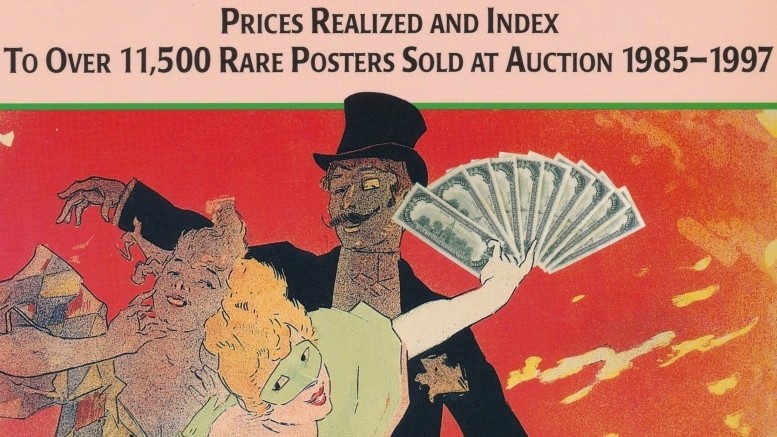The valuation and assessment of posters can be carried out according to very different parameters. There is sometimes a considerable difference between the market valuation of a poster, i.e. its actual current value in monetary terms on the one hand, and its ideal value, based on various conditions on the other. This difference is always of importance when the various valuation parameters come directly into contact with one another.
The monetary value of a poster is regulated by the market. Its price is generally determined by the interaction of supply and demand.
Specifically, the market value of a poster is determined by factors such as how well-known the artist is, as well as its rarity value, condition, mode, motif and special interest, etc. A number of dealers and auction houses have become established in this area, and these are professionally capable of undertaking market valuations of posters and recognizing trends – which they can sometimes reinforce or undermine by the posters they put up for offer.
Auction prices which have been achieved are still used as a yardstick for determining the insurance value of similar posters in other collections. It is at the latest at this point that the problem of valuation begins. The poster which goes under the hammer at any particular auction is of a specific size and in a specific condition, and the group of interested parties and potential purchasers at the auction is a chance, possibly even unique combination. In conjunction with the valuation factors discussed above – sometimes guided by irrationality – a price is arrived at.
It is, though, not clear whether the price thus achieved represents the market value of the poster or whether it is no more than the expression of a specific constellation of bidders.
Only the observation of the price development of a poster over a long period is likely to be able to give any indication of its average and thus „real” value.
The ideal value of a piece arises on the one hand very generally from its position within regional, national or international poster history, and specifically within the collecting profile of the poster collection, e.g. of a museum, an archive or a collector. In an extended sense, this naturally also applies to the subjective evaluation of posters e.g. in private collections. Memories or particular experiences with which a poster is associated represent an inner linkage, an individualized value. The ideal value is thus directly dependent on the collecting objective or the conservation purpose.
A politically orientated museum is unlikely to have any great interest in posters created by great artists. If a collection concentrates on Swiss posters, posters from other countries are likely to be given a lower valuation. If someone collects posters on a particular subject, then posters of different subjects will be of less interest. In any particular specialized collection, the question that will be asked when a purchase or exchange looms is: is this or that poster important or indispensable for our collection; and how much, in monetary terms, is it worth to us?
Only at this stage does the market orientation begin. It is at this point that it is determined whether the desired posters are amazingly cheaply priced in the marketplace or are beyond reach. And this is where the problems begins: very different valuation systems need to find some area of common ground.
There seems to be no problem in the case of the purchase of posters at auctions or galleries. In these cases, the purchasers simply has to accept the existing valuations. Matters are very different in the case of exchange, especially as more and more museums and archives (because of a lack of money) will be forced, as will the trade, to be constantly on the look-out for new sources with which they will have to deal. But it is precisely in the sphere of the exchange that the danger lurks that one or the other side will, in the last analysis, feel it has been unjustly treated (in extreme cases, this could even apply to both parties to the exchange!). This is certainly always a possibility. The following steps set out to explain how this can be preempted, from the perspective of differing valuations of posters.
- The process should not be hurried, and should be expected to take a considerable amount of time.
- The more detailed the preliminary discussions, the better the mutual understanding.
- It is sensible to obtain additional information about the collection or personal details about the potential other party to the exchange (respecting the necessary discretion).
- Priorities (ideal and financial) should be determined when putting together posters for exchange.
- The exchange comparison should never be undertaken solely on the basis of the potential market value (it is essential for anyone not involved in the market to seek neutral advice).
- The exchange comparison should always take into consideration the ideal value.
- From the very start of the procedure, the question should be repeatedly asked: would I repeat this exchange (if it proceeds as planned)? If this question can be answered in the affirmative, then the matter should be pursued.
- Whether a written agreement is required, is a matter which should be decided from case to case.
If, then, the process is not hurried, there is plenty of preliminary discussion and advice is sought from neutral experts, then a good deal of groundwork will have been put in to help avoid bad feeling after the exchange on one side or the other. For one single exchange which grossly violates the principle of mutuality and is undertaken at the expense of one of the parties, will sooner or later go the rounds in the small poster-collecting community, and could lead to a general ending of poster exchanges between differing valuation systems. This should not be allowed to happen.
Exchanges give the opportunity for both sides of the bargain to extend their collection on favourable terms and, in the ideal case, to develop long-term exchange relationships. There is a particular danger of an unfair exchange when insufficient consideration is given to the mutual and different interests in posters in the exchange.
Revised version of: Grohnert, René: No Two Values are the Same, in: PlakatJournal 1997/2, p.19ff.
Translation: Jörn Weigelt




